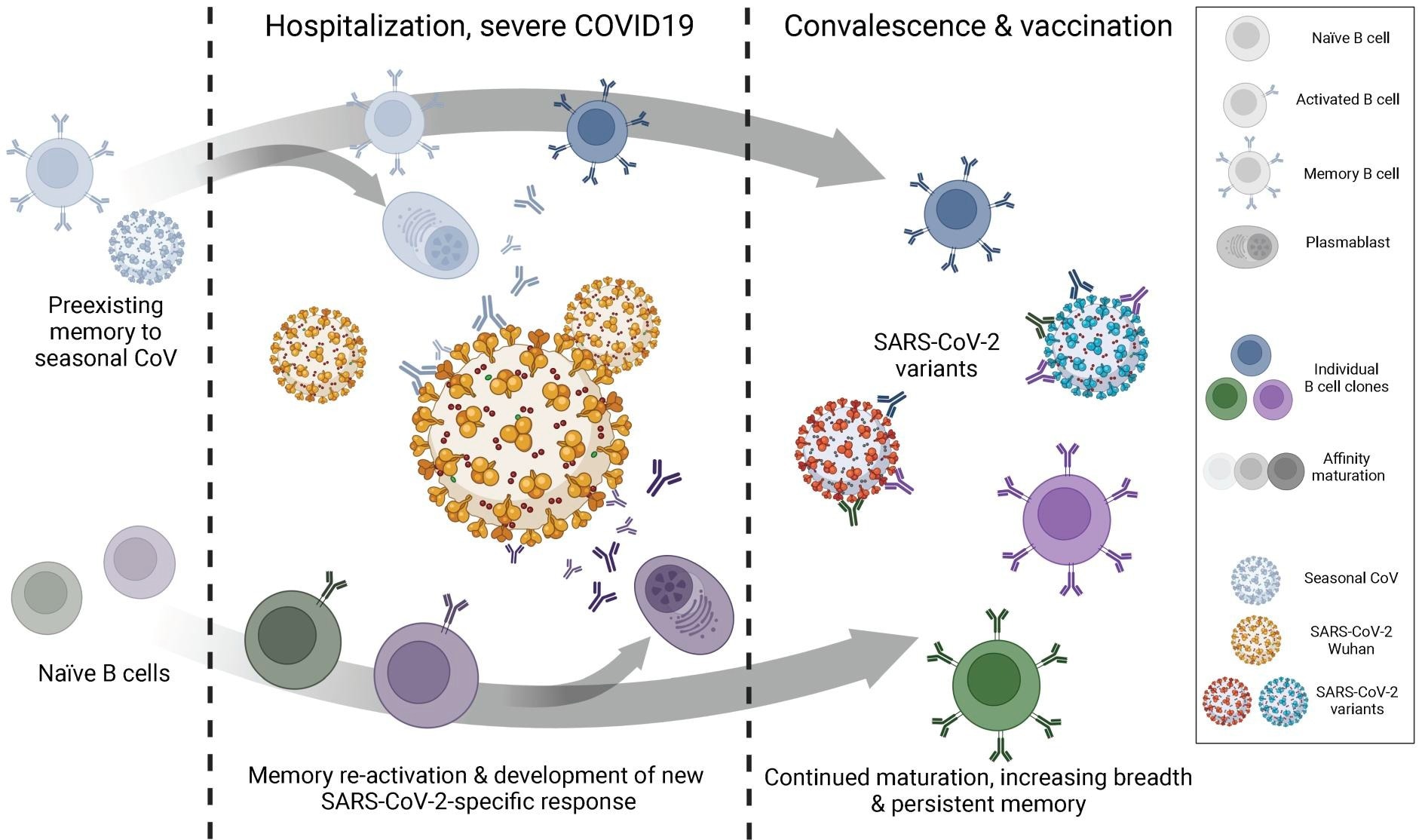Severe acute respiratory syndrome coronavirus-2 (SARS-CoV-2), the causal agent of the coronavirus disease 2019 (COVID-19) pandemic, has globally infected more than 639 million individuals and claimed over 6.6 million lives. Despite the rapid commencement of COVID-19 vaccination programs in most countries across the world, the virus has remained in circulation. This is mainly because of the continual emergence of new SARS-CoV-2 variants, such as the Omicron and Delta strains, which can escape immune responses induced via vaccination and natural infection.
 Study: Longitudinal single-cell analysis of SARS-CoV-2-reactive B cells uncovers persistence of early-formed, antigen specific clones
Study: Longitudinal single-cell analysis of SARS-CoV-2-reactive B cells uncovers persistence of early-formed, antigen specific clones
Background
Many studies have reported the generation of early immune responses upon infection. In severely infected COVID-19 patients, an increased number of Th1-like CD8 and CD4 cells, plasmablasts, erythroid cells, and megakaryocytes were detected. Additionally, spike (S)-binding, neutralizing antibodies (Abs) of the IgA and IgG isotypes were found in the early phase of the infection.
The emergence of SARS-CoV-2 variants has drawn more attention to the study of memory B cells (MBC). Animal model studies on influenza indicated that the MBC pool possesses a greater breadth of antigenic binding than the plasmablast response. This finding implies that plasma cells and serum Abs protect against reinfection with the same viral strain, while the MBC pool can protect against a diverse range of emerging variants.
The assessment of the MBC development after COVID-19 revealed an ongoing increase of B cell receptor (BCR) mutations, which was at par with antigen persistence and continuing germinal center (GC) activity. This increasing number of mutations also enhanced the neutralization breadth of the MBC pool.
The development of monoclonal antibodies (mAbs) cloned from SARS-CoV-2 infected patients at different points of infection revealed considerable neutralizing breadth against viral variants. However, longitudinal research examining the immune response of the same patients during hospitalization, after recovery, and after vaccination is lacking.
About the Study
A recent JCI Insight study addressed this gap in research and utilized a longitudinal approach to provide important insights into the evolution of B cells after viral infections. This study recruited six severe/critically infected SARS-CoV-2 patients post-hospital admission at Sahlgrenska University Hospital, Sweden. They were followed through the disease progression and recovery period for up to one year.
The patients' blood and serum samples were collected every three days during hospitalization. In addition, post-discharge samples were collected every three months for up to one year. Overall, 50% of the study cohort received COVID-19 vaccination by the end of the follow-up period.
The samples were used to measure total peripheral blood mononuclear cells (PBMCs) and B cells, based on single cell transcriptomics, expression of surface proteins, antigen binding (Spike (S), Nucleocapsid (N) or Receptor Binding Domain (RBD)), and BCR sequences, at each of the analyzed time points.
Study Findings
The longitudinal study design enabled scientists to trace the origin of antigen-specific B cells and understand their evolution pattern in each patient. A significant change in the circulating immune populations was observed during the infection. During the early phase of hospitalization, CD4 T cells with strong IFN signatures were detected, which disappeared within 3 months.
After 14 days of hospital admission, immune cell composition or transcriptional features stabilized. However, due to the small sample size, it was challenging to make a firm conclusion about the association between the analyzed immune responses, comorbidities, and general immune status.
Three patients with respiratory comorbidities did not reveal any significant difference in the number of the different immune cell populations or B cells. Overall, irrespective of sex, comorbidities, age, and immune status, a similar immune response was observed in all patients.
After SARS-CoV-2 infection, a significant expansion of B cell clones was not observed; smaller clones were detected in all samples at all-time points, including plasmablast. However, early plasmablasts did not persist for the entire year, even after vaccination. Notably, mAbs of the same patient, belonging to the same clonal family, acquired an improved binding capacity to different viral variants over time. This finding implies persistent ongoing clonal affinity maturation.
Notably, after COVID-19 recovery, a significant expansion of MBC with increased frequency of antigen-specific B cells and greater somatic hypermutation across binders were observed. COVID-19 vaccination did not accelerate this process. The findings of this study suggested that vaccination was not enough to induce strong clonal expansion and reactivation of infection-derived MBC. However, analytical data from sera revealed that after vaccination, a prominent differentiation of MBC into Ab-secreting plasmablasts occurred.
A gene ontology analysis revealed that switched immunoglobulin (swIg) MBC possessed a greater activated transcriptional signature than IgM MBC. Furthermore, it was found that RBD-specific swIg-MBC were more inclined to get reactivated upon reinfection.
Conclusions
In summary, the current study revealed the presence of COVID-19 persisting clones that were first induced after infection. These clones were maintained for up to one year while they improved their binding capacity and neutralizing breath. In the future, more research must be conducted to understand if similar clones can be reactivated upon vaccination or reinfection.